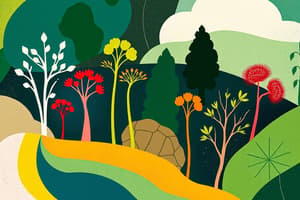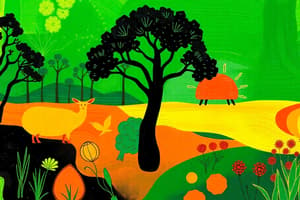Podcast
Questions and Answers
Which of the following is NOT a type of selection?
Which of the following is NOT a type of selection?
- Disruptive
- Sympatric (correct)
- Directional
- Stabilizing
What are biomes?
What are biomes?
- The interactions between different species in a community.
- Large-scale ecosystems characterized by specific climate and vegetation types. (correct)
- Small, isolated habitats within a larger ecosystem.
- The study of the distribution of organisms across the globe.
Which of the following studies would be best suited for small, mobile animals?
Which of the following studies would be best suited for small, mobile animals?
- Mark-recapture
- Transect sampling
- Radio telemetry (correct)
- Quadrat sampling
The logistic growth curve incorporates which of the following?
The logistic growth curve incorporates which of the following?
When two species with very similar ecological niches are placed together, what is a likely outcome according to the sources?
When two species with very similar ecological niches are placed together, what is a likely outcome according to the sources?
Which of the following is true about mutualism?
Which of the following is true about mutualism?
What are pioneer species?
What are pioneer species?
What is the difference between primary and secondary ecological succession?
What is the difference between primary and secondary ecological succession?
A rank abundance curve shows which of the following?
A rank abundance curve shows which of the following?
What is the most common cause of species loss globally?
What is the most common cause of species loss globally?
What two factors generally promote primary production?
What two factors generally promote primary production?
What soil layer is characteristic of desert environments?
What soil layer is characteristic of desert environments?
What term describes the efficiency of an organism at converting consumed food into its own biomass or offspring?
What term describes the efficiency of an organism at converting consumed food into its own biomass or offspring?
Which of the following organism types are generally NOT very efficient at converting food into biomass due to high metabolic rates?
Which of the following organism types are generally NOT very efficient at converting food into biomass due to high metabolic rates?
What concept describes the distance a nutrient atom travels downstream in a stream before it is fully cycled?
What concept describes the distance a nutrient atom travels downstream in a stream before it is fully cycled?
What are the primary agents of decomposition in most ecosystems?
What are the primary agents of decomposition in most ecosystems?
Why might insects be a less desirable food source for a predator compared to something like soft-bodied prey?
Why might insects be a less desirable food source for a predator compared to something like soft-bodied prey?
Which plant component is slow to decompose?
Which plant component is slow to decompose?
What combination of environmental factors leads to the fastest decomposition rates?
What combination of environmental factors leads to the fastest decomposition rates?
Which of the following is a layer found in lakes and oceans?
Which of the following is a layer found in lakes and oceans?
What term describes a body of water where freshwater mixes with saltwater?
What term describes a body of water where freshwater mixes with saltwater?
Animals respire and release carbon dioxide into the atmosphere, which is then taken up by plants for photosynthesis. This is an example of:
Animals respire and release carbon dioxide into the atmosphere, which is then taken up by plants for photosynthesis. This is an example of:
Which of the following is true about the phosphorus cycle?
Which of the following is true about the phosphorus cycle?
Which forms of nitrogen can be readily used by plants?
Which forms of nitrogen can be readily used by plants?
What is convergent evolution?
What is convergent evolution?
What is biogeography?
What is biogeography?
Where is plant diversity generally the greatest?
Where is plant diversity generally the greatest?
What are epiphytes?
What are epiphytes?
Where are Earth's major deserts located?
Where are Earth's major deserts located?
What change occurs during ecological succession that increases the diversity of lichens?
What change occurs during ecological succession that increases the diversity of lichens?
What does the term "benthic zone" refer to?
What does the term "benthic zone" refer to?
What does the term "littoral zone" refer to?
What does the term "littoral zone" refer to?
What is the difference between oligotrophic and eutrophic lakes?
What is the difference between oligotrophic and eutrophic lakes?
What does the logistic growth equation describe?
What does the logistic growth equation describe?
What does the exponential growth equation describe?
What does the exponential growth equation describe?
What is unique about bogs?
What is unique about bogs?
What does the acronym AET stand for?
What does the acronym AET stand for?
Why is AET a good index of primary production?
Why is AET a good index of primary production?
What does the Lotka-Volterra equation describe?
What does the Lotka-Volterra equation describe?
How can the Lotka-Volterra equation be used in ecology?
How can the Lotka-Volterra equation be used in ecology?
What does sustainable yield refer to in conservation biology?
What does sustainable yield refer to in conservation biology?
What is the SLOSS debate in conservation biology?
What is the SLOSS debate in conservation biology?
What factor contributed to the greater tree diversity in Eastern Asia compared to the United States and Europe?
What factor contributed to the greater tree diversity in Eastern Asia compared to the United States and Europe?
Ecological disturbances vary in which of the following?
Ecological disturbances vary in which of the following?
Which of the following industries can the concept of sustainable yield be applied to?
Which of the following industries can the concept of sustainable yield be applied to?
What is the current major extinction event caused by?
What is the current major extinction event caused by?
Which species are at the highest risk of extinction?
Which species are at the highest risk of extinction?
What does the equilibrium model of island biogeography suggest?
What does the equilibrium model of island biogeography suggest?
What does the term "endemic" mean?
What does the term "endemic" mean?
What is a metapopulation?
What is a metapopulation?
What is a metacommunity?
What is a metacommunity?
What does the term "sympatric" mean?
What does the term "sympatric" mean?
What mechanisms have been proposed to drive ecological succession?
What mechanisms have been proposed to drive ecological succession?
What does the Shannon-Wiener Diversity Index measure?
What does the Shannon-Wiener Diversity Index measure?
Which of the following gases are greenhouse gases?
Which of the following gases are greenhouse gases?
Which of the following is true about the role of oceans in the carbon cycle?
Which of the following is true about the role of oceans in the carbon cycle?
Flashcards
Directional Selection
Directional Selection
A type of natural selection where one extreme phenotype is favored, shifting the population towards that trait. Think of giraffes with longer necks reaching higher leaves, giving them an advantage.
Stabilizing Selection
Stabilizing Selection
A type of natural selection where the average phenotype is favored, reducing variation and maintaining the status quo. Picture a bird with a medium-sized beak, best for both small and large seeds.
Disruptive Selection
Disruptive Selection
A type of natural selection where both extreme phenotypes are favored, leading to increased variation and potentially even speciation. Imagine a bird with either small or large beaks, specializing on different food sources.
Biome
Biome
Signup and view all the flashcards
Radio Telemetry
Radio Telemetry
Signup and view all the flashcards
Quadrat Sampling
Quadrat Sampling
Signup and view all the flashcards
Mark-Recapture
Mark-Recapture
Signup and view all the flashcards
Transect Sampling
Transect Sampling
Signup and view all the flashcards
Logistic Growth Curve
Logistic Growth Curve
Signup and view all the flashcards
Carrying Capacity
Carrying Capacity
Signup and view all the flashcards
Competitive Exclusion
Competitive Exclusion
Signup and view all the flashcards
Mutualism
Mutualism
Signup and view all the flashcards
Obligate Mutualism
Obligate Mutualism
Signup and view all the flashcards
Facultative Mutualism
Facultative Mutualism
Signup and view all the flashcards
Pioneer Species
Pioneer Species
Signup and view all the flashcards
Primary Succession
Primary Succession
Signup and view all the flashcards
Secondary Succession
Secondary Succession
Signup and view all the flashcards
Rank Abundance Curve
Rank Abundance Curve
Signup and view all the flashcards
Habitat Loss
Habitat Loss
Signup and view all the flashcards
Primary Production
Primary Production
Signup and view all the flashcards
Eutrophic Lake
Eutrophic Lake
Signup and view all the flashcards
Oligotrophic Lake
Oligotrophic Lake
Signup and view all the flashcards
Assimilation Efficiency
Assimilation Efficiency
Signup and view all the flashcards
Production Efficiency
Production Efficiency
Signup and view all the flashcards
Detritivores
Detritivores
Signup and view all the flashcards
Convergent Evolution
Convergent Evolution
Signup and view all the flashcards
Biogeography
Biogeography
Signup and view all the flashcards
Epiphyte
Epiphyte
Signup and view all the flashcards
AET (Actual Evapotranspiration)
AET (Actual Evapotranspiration)
Signup and view all the flashcards
Lotka-Volterra Equation
Lotka-Volterra Equation
Signup and view all the flashcards
Sustainable Yield
Sustainable Yield
Signup and view all the flashcards
SLOSS Debate
SLOSS Debate
Signup and view all the flashcards
Equilibrium Model of Island Biogeography
Equilibrium Model of Island Biogeography
Signup and view all the flashcards
Metapopulation
Metapopulation
Signup and view all the flashcards
Metacommunity
Metacommunity
Signup and view all the flashcards
Allopatric Speciation
Allopatric Speciation
Signup and view all the flashcards
Sympatric Speciation
Sympatric Speciation
Signup and view all the flashcards
Ectotherm
Ectotherm
Signup and view all the flashcards
Endotherm
Endotherm
Signup and view all the flashcards
Homeotherm
Homeotherm
Signup and view all the flashcards
Poikilotherm
Poikilotherm
Signup and view all the flashcards
Density-Dependent Factor
Density-Dependent Factor
Signup and view all the flashcards
Density-Independent Factor
Density-Independent Factor
Signup and view all the flashcards
Gauss's Principle of Competitive Exclusion
Gauss's Principle of Competitive Exclusion
Signup and view all the flashcards
Fundamental Niche
Fundamental Niche
Signup and view all the flashcards
Realized Niche
Realized Niche
Signup and view all the flashcards
Allee Effect
Allee Effect
Signup and view all the flashcards
Keystone Species
Keystone Species
Signup and view all the flashcards
Desertification
Desertification
Signup and view all the flashcards
Study Notes
Ecology Study Notes
- Ecology is the study of the interactions between organisms and their environment.
- Biomes are large-scale ecosystems characterized by specific climates and vegetation types.
- Sympatric selection is a type of natural selection where different species live in the same area.
- Directional selection favors one extreme phenotype.
- Stabilizing selection favors the average phenotype.
- Disruptive selection favors both extreme phenotypes.
- Biomes include tropical rainforests, temperate forests, deserts, tundras, grasslands, and others.
- Mutualism is a symbiotic relationship where both species benefit.
- Mutualistic relationships can be obligate or facultative.
- Obligate relationships are essential for survival, while facultative relationships are beneficial but not essential.
- Pioneer species are the first species to colonize a newly available habitat.
- Primary succession occurs on newly exposed substrates, often after a disturbance like a volcanic eruption.
- Secondary succession occurs where soil is already present.
- Succession leads to increasingly complex communities over time.
- Exponential growth occurs when resources are unlimited.
- Logistic growth occurs when resources are limited, reaching a carrying capacity.
- Carrying capacity is the maximum population size an environment can support.
- Climate change is a major cause of species loss globally.
- Invasive species contribute to species loss globally.
- Pollution is a major cause of species loss globally.
- Habitat loss is a major cause of species loss globally.
- Primary productivity is the rate at which producers (plants) convert energy from sunlight into biomass.
- Temperature and moisture are key factors in primary production.
- Soil horizons are distinct layers of soil.
- Decomposers (bacteria and fungi) are key agents of decomposition.
- Decomposition rates are affected by various factors.
- In Primary Succession, the Pioneer Species are typically R-selected species that are well-suited for rapidly colonizing bare substrates, such as lichen and mosses.
- In Secondary Succession, the Pioneer Species are often different, as they are dealing with existing soil and its nutrient content.
- Phosphorus cycle does not have a significant atmospheric component.
- Nitrogen exists in various forms, with some being directly usable by plants like nitrate and ammonium.
- Convergent evolution refers to unrelated species evolving similar traits due to similar environmental pressures.
- Biogeography is the study of the distribution of organisms across the globe.
- Plant diversity is generally greatest in the tropics.
- Epiphytes are plants that grow on other plants.
- Deserts are characterized by low precipitation and temperatures.
- Latitude, altitude, and substrate influence decomposition rates.
- Metapopulation is a group of spatially separated populations of the same species connected by dispersal.
- Metacommunity is a group of interacting communities that are linked by dispersal.
- Sympatric species occur in the same geographic area.
- Allopatric species occur in different geographic areas.
- Eutrophic lakes have high nutrient levels.
- Oligotrophic lakes have low nutrient levels.
- Logistic growth curve models population growth affected by limited resources.
- Exponential growth curve models population growth with unlimited resources.
- Carrying capacity is the maximum population size an environment can support.
- Density-dependent factors influence population size based on population density.
- Density-independent factors influence population size regardless of population density.
- Fundamental niche is the total range of resources a species can use.
- Realized niche is the actual range of resources a species uses considering interactions with other species.
- Allee effect is when population growth rate decreases at low densities.
- Ectotherms rely on external sources of heat.
- Endotherms generate their own body heat.
- Homeotherms maintain a constant body temperature, while Poikilotherms have varying body temperatures.
- Keystone species have a disproportionately large impact on their ecosystem.
- Biomes are large-scale ecosystems with specific climate conditions.
- Succession is the process of ecological change over time in a community.
- Species are the basic unit of classification and evolution.
- Evolutionary relationships are important to understanding how species interact in their environment.
- Climate change effects are notable in disrupting natural ecosystems.
- Carbon cycle relies on various components of Earth's system for exchange.
- Ozone layer protection is important to Earth's atmosphere.
Studying That Suits You
Use AI to generate personalized quizzes and flashcards to suit your learning preferences.




